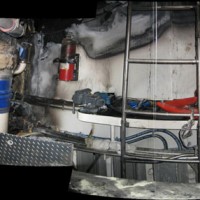Yachts are equipped with fire protection systems to prevent extensive damage, protect lives and ensure safety. However, in order for these systems to be fully effective, they must be properly designed, installed, inspected and maintained.
When a fire occurred in the engine room of a yacht under power at sea off the coast of Florida, the engine room’s fire suppression system did not activate. We were retained on behalf of the yacht manufacturer to conduct an engineering investigation and to determine if a condition of defect in the fire suppression system equipment or installation prevented the system from activating.
The engine room’s fire suppression system had provisions for manual and automatic actuation. The manual actuation could be accomplished at either the local suppressant storage cylinder or at a manual pull station located next to the engine room entrance door. Automatic actuation could be accomplished via a pneumatic fire detection system that incorporated a pressure-sensitive CO2 control head valve and two heat-activated detectors (HADs).
An analysis of the engine room showed a high probability that nearby combustibles had been ignited by the port engine exhaust pipe. Heat from the resultant fire spread in the engine room and affected the room’s contents to varying degrees. The upper area of the room where the HADs were located was subjected to elevated temperatures and yet the fire suppression system did not activate. Normally, the rate of rise in temperature would cause pressurization of the HADs and the pneumatic circuit, and trigger the CO2 actuating head.
What prevented the system from detecting this fire? There were three possible reasons identified:
1. Insufficient rate of temperature rise at the subject detector locations.
We had proof this was not the case. Recorded engine room data showed a temperature rise at the time of the fire that should have actuated the system. In fact, nearby plastic lighting lenses were sagged and semi-melted, indicating the HADs were exposed to significant levels of heating. The rate of rise and duration should have been sufficient to activate the system.
2. Failure of the CO2 actuating head to sense the rise in pressure in the pneumatic detection system?
According to several examinations — both before and after the fire — the CO2 actuating head was capable of activating. It would be unusual for the system to have a working actuating head before and after the fire, but fail during the fire. In this case, however, if the actuating head was exposed to considerable heat during the fire — and it was — the actuation point could have been affected. The potential for the fire to have affected the actuation head could not be entirely dismissed, although this method of system failure was considered unlikely.
3. Leak in the pneumatic detection system?
A leak in the pneumatic sensing system will also prevent sufficient buildup of pressure in the detection system and prevent actuation. The system in this case is known to be free from gross leakage, proven through heat gun testing before and after the fire. A heat gun is essentially a very high temperature blow dryer. The very high rates of temperature rise from heat gun testing will detect gross leakage, however not necessarily smaller leaks. A small leak in the pneumatic detection system could have existed and prevented the system from actuating.
The manufacturer’s instructions outlined a testing procedure that would have found even very small leaks. The installing contractor had failed to utilize this procedure, despite the manufacturers recommendations and the requirement of NFPA 2001 Standard on Clean Agent Fire Extinguishing Systems to “Check pneumatic equipment, where required, for integrity to ensure proper operation.” Additionally, the forensic engineers who initially examined the system also failed to properly check for leaks, then dismantled the system, preventing me from ever knowing with certainty the pneumatic integrity of the system.
Because the system had been improperly examined and dismantled before my involvement, we were unable to determine with certainty the reason the system did not discharge. However, we were able to determine the system installer should have detected a leak at installation if there was one present, but failed to conduct the specified tests to ensure a leak free installation. This despite their certification the system had been installed “in accordance with NFPA, the manufacturers and USCG recommendations.”
Founded in 1997, The Warren Group, forensic engineers and consultants provides technical investigations and analysis of personal injury and property claims as well as expert testimony for insurance adjusters and attorneys. Extremely well versed in the disciplines of mechanical, electrical, chemical, structural, accident reconstruction and fire and explosion investigation, our engineers and consultants are known for delivering the truth — origin, cause, responsibility and cost of an event or claim — with unmistakable clarity.





